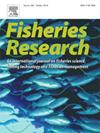Evidence of growth-selective mortality of European anchovy larvae in the Bay of Biscay based on otolith microstructure analysis
IF 2.2
2区 农林科学
Q2 FISHERIES
引用次数: 0
Abstract
We tested the hypothesis that anchovy juveniles that survived until autumn in the Bay of Biscay were the larger and faster-growing members of their cohorts. Anchovy larvae and post-larvae were collected in August 2005 and juveniles in September-October 2005 in the south-eastern part of the Bay of Biscay. Their otoliths were analysed, and larval, post-larval, and juvenile hatch date distributions, as well as daily growth patterns, were estimated. Subsequently, larval growth trajectories of juveniles were compared with those of larvae and post-larvae from the same cohort. Additionally, a generalised additive mixed model was applied to characterize otolith growth trajectory. Juveniles exhibited higher growth rates than larvae and post-larvae, providing evidence of growth-selective mortality. These differences were observed from 16 to 20 days onwards and could be related to the onset of diel vertical migration and/or larval aggregation. Our results support the hypothesis that fast growth increases the survivorship of anchovy during the larval stage. These findings contribute to a better understanding of the role of predation pressure on anchovy survival in the Bay of Biscay.
求助全文
约1分钟内获得全文
求助全文
来源期刊

Fisheries Research
农林科学-渔业
CiteScore
4.50
自引率
16.70%
发文量
294
审稿时长
15 weeks
期刊介绍:
This journal provides an international forum for the publication of papers in the areas of fisheries science, fishing technology, fisheries management and relevant socio-economics. The scope covers fisheries in salt, brackish and freshwater systems, and all aspects of associated ecology, environmental aspects of fisheries, and economics. Both theoretical and practical papers are acceptable, including laboratory and field experimental studies relevant to fisheries. Papers on the conservation of exploitable living resources are welcome. Review and Viewpoint articles are also published. As the specified areas inevitably impinge on and interrelate with each other, the approach of the journal is multidisciplinary, and authors are encouraged to emphasise the relevance of their own work to that of other disciplines. The journal is intended for fisheries scientists, biological oceanographers, gear technologists, economists, managers, administrators, policy makers and legislators.
 求助内容:
求助内容: 应助结果提醒方式:
应助结果提醒方式:


